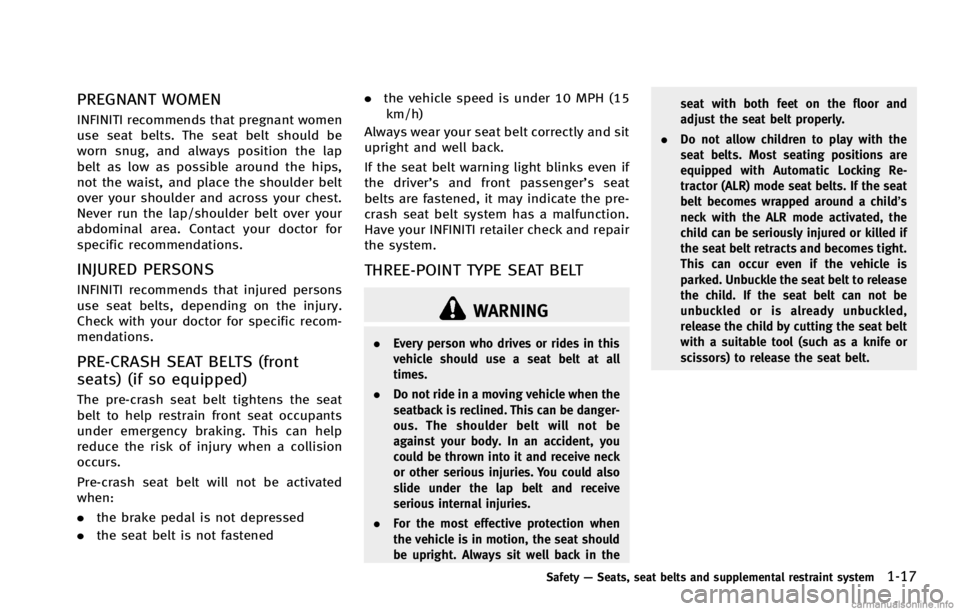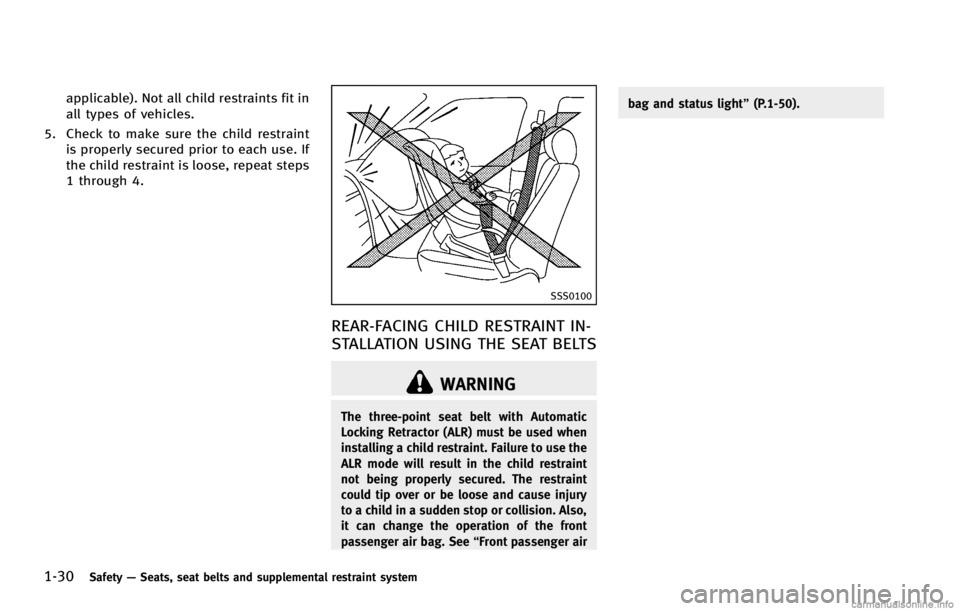lock INFINITI G COUPE 2013 Owner's Manual
[x] Cancel search | Manufacturer: INFINITI, Model Year: 2013, Model line: G COUPE, Model: INFINITI G COUPE 2013Pages: 490, PDF Size: 7.25 MB
Page 18 of 490

GUID-5BF1CCAC-1271-471E-83A1-FF109419BE46
SSI0671
1. Side ventilator (P.4-30)
2. Meters and gauges (P.2-6)
3. Center ventilator (P.4-30)
4. Audio system (P.4-41)
5. Clock (P.2-43)
6. Center multi-function control panel—
Navigation system* (if so
equipped)
— Vehicle information and setting
buttons (P.4-9)
— Bluetooth
®Hands-Free Phone Sys-
tem (if so equipped) (P.4-85, P.4-96) —
Audio system (P.4-41)
7. Center display (P.4-3)/Navigation sys- tem* (if so equipped)
8. Hazard warning flasher switch (P.2-39)
9. Front passenger supplemental air bag (P.1-42)
10. Fuse box cover (P.8-24)
11. Parking brake (for Automatic Trans- mission models)
—Parking (P.5-21)
12. Push-button ignition switch (P.5-9)
13. Automatic climate control system (P.4-31)
14. Cigarette lighter and ashtray (if so equipped) (P.2-44) or storage box (if
so equipped) (P.2-50)
—Power outlet (if so equipped)
(P.2-43)
15. Parking brake (for Manual Transmis- sion models)
—Parking (P.5-21)
16. Heated seat switch (if so equipped) (P.2-40)
17. SNOW mode switch (if so equipped) (P.2-42)
18. Rear window and outside mirror (if so equipped) defroster switch (P.2-34)
Illustrated table of contents0-11
INSTRUMENT PANEL
Page 22 of 490

GUID-20167C10-9FEC-49A8-BD90-B52F0ED487EA
All-Wheel Drive (AWD) warning
light (AWD models)*2-12
Anti-lock Braking System (ABS)
warning light2-13
Automatic Transmission check
warning light
2-13
Brake warning light
2-13
Charge warning light2-14
Engine oil pressure warning
light 2-14
4 Wheel Active Steer (4WAS)
warning light*
2-14
Intelligent Cruise Control (ICC)
system warning light (orange)*2-15
Intelligent Key warning light 2-15
Low tire pressure warning light 2-15
Master warning light
2-16
Preview Function warning light
(orange)* 2-16
Seat belt warning light 2-17
Supplemental air bag warning
light2-17Warning
light Name Page
Vehicle Dynamic Control (VDC)
warning light 2-17
Indicator light Name Page
Automatic Transmission posi-
tion indicator light* 2-18
Exterior light indicator
2-18
Front fog light indicator light 2-18
Front passenger air bag status
light 2-18
High beam indicator light 2-18
Malfunction Indicator Light
(MIL)2-18
Security indicator light 2-19
Turn signal/hazard indicator
lights2-19
Vehicle Dynamic Control (VDC)
off indicator light2-19
*: if so equipped
Illustrated table of contents0-15
WARNING AND INDICATOR LIGHTS
Page 25 of 490

1-2Safety—Seats, seat belts and supplemental restraint system
GUID-15F58BF2-1182-4C7C-8EA9-0FDFD873D801
SSS0133
WARNING
. Do not ride in a moving vehicle when the
seatback is reclined. This can be danger-
ous. The shoulder belt will not be
against your body. In an accident, you
could be thrown into it and receive neck
or other serious injuries. You could also
slide under the lap belt and receive
serious internal injuries.
. For the most effective protection when
the vehicle is in motion, the seat should
be upright. Always sit well back in the seat with both feet on the floor and
adjust the seat belt properly. See
“Pre-
cautions on seat belt usage” (P.1-14).
. After adjustment, gently rock in the seat
to make sure it is securely locked.
. Do not leave children unattended inside
the vehicle. They could unknowingly
activate switches or controls. Unat-
tended children could become involved
in serious accidents.
. The seatback should not be reclined
further than necessary for comfort. Seat
belts are most effective when the pas- senger sits well back and straight up in
the seat. If the seatback is reclined, the
risk of sliding under the lap belt and
being injured is increased.
CAUTION
When adjusting the seat positions, be sure
not to contact any moving parts to avoid
possible injuries and/or damages.
SEATS
Page 29 of 490

1-6Safety—Seats, seat belts and supplemental restraint system
SSS0786
Walk-in mechanism (Coupe):GUID-D73A39BF-43C8-459F-9C24-47B7F579C407
CAUTION
. When returning the seat to its original
position, confirm the seat and seatback
are locked properly.
. Be careful not to pinch your hand or foot
or bump your head when operating the
walk-in seat.
. While operating the walk-in seat, do not
operate the seatback reclining switch.
The reclining motor may be damaged.
. Do not place any objects near the
seatback of the front seats. They may
be pinched and damaged.
The automatic forwarding and reversing
will not work or stop under the following
conditions:
.When the vehicle speed is above 4 MPH
(7 km/h) (driver’s seat only).
. When the seat belt is fastened.
. When the selector lever is not in the P
(Park) position (Automatic Transmis-
Page 30 of 490

WARNING
.Never allow anyone to ride in the cargo
area or on the rear seat when it is in the
fold-down position. Use of these areas
by passengers without proper restraints
could result in serious injury in an
accident or sudden stop.
. Properly secure all cargo with ropes or
straps to help prevent it from sliding or
shifting. Do not place cargo higher than
the seatbacks. In a sudden stop or
collision, unsecured cargo could cause
personal injury.
. When returning the seatbacks to the
upright position, be certain they are
completely secured in the latched posi-
tion. If they are not completely secured,
passengers may be injured in an acci-
dent or sudden stop.
. Closely supervise children when they are
around cars to prevent them from play-
ing and becoming locked in the trunk
where they could be seriously injured.
Keep the car locked, with the rear seatback and trunk lid securely latched
when not in use, and prevent children’s
access to car keys.
The rear seatback can be folded according
to the following procedure.
Safety
—Seats, seat belts and supplemental restraint system1-7
Page 34 of 490

SSS0994
To lower, push and hold the lock knob and
push the head restraint down.
SSS0995
RemovalGUID-57DF10FD-7FAA-4FB1-8D61-CC400E811A0D
Page 40 of 490

WARNING
.Every person who drives or rides in this
vehicle should use a seat belt at all
times.
. Do not ride in a moving vehicle when the
seatback is reclined. This can be danger-
ous. The shoulder belt will not be
against your body. In an accident, you
could be thrown into it and receive neck
or other serious injuries. You could also
slide under the lap belt and receive
serious internal injuries.
. For the most effective protection when
the vehicle is in motion, the seat should
be upright. Always sit well back in the seat with both feet on the floor and
adjust the seat belt properly.
. Do not allow children to play with the
seat belts. Most seating positions are
equipped with Automatic Locking Re-
tractor (ALR) mode seat belts. If the seat
belt becomes wrapped around a child’s
neck with the ALR mode activated, the
child can be seriously injured or killed if
the seat belt retracts and becomes tight.
This can occur even if the vehicle is
parked. Unbuckle the seat belt to release
the child. If the seat belt can not be
unbuckled or is already unbuckled,
release the child by cutting the seat belt
with a suitable tool (such as a knife or
scissors) to release the seat belt.
Safety —Seats, seat belts and supplemental restraint system1-17
Page 41 of 490

1-18Safety—Seats, seat belts and supplemental restraint system
SSS0292
Fastening the seat beltsGUID-B37DD1F9-9FF6-46C4-80B5-F68C6BFB1F41
SSS0290
3. Position the lap belt portion low and
snug on the hips as shown.
4. Pull the shoulder belt portion toward the retractor to take up extra slack. Be
sure the shoulder belt is routed over
your shoulder and across your chest.
The three-point type seat belts have two
modes of operation:
. Emergency Locking Retractor (ELR)
. Automatic Locking Retractor (ALR)
The Emergency Locking Retractor (ELR)
mode allows the seat belt to extend and
retract to allow the driver and passengers
some freedom of movement in the seat.
Page 45 of 490

1-22Safety—Seats, seat belts and supplemental restraint system
GUID-758C3ADB-56E4-4839-A833-17F0574CC784
WARNING
Do not allow children to play with the seat
belts. Most seating positions are equipped
with Automatic Locking Retractor (ALR)
mode seat belts. If the seat belt becomes
wrapped around a child’s neck with the ALR
mode activated, the child can be seriously
injured or killed if the seat belt retracts and
becomes tight. This can occur even if the
vehicle is parked. Unbuckle the seat belt to
release the child. If the seat belt can not be
unbuckled or is already unbuckled, release
the child by cutting the seat belt with a
suitable tool (such as a knife or scissors) to
release the seat belt.
Children need adults to help protect them.
They need to be properly restrained.
In addition to the general information in
this manual, child safety information is
available from many other sources, includ-
ing doctors, teachers, government traffic
safety offices, and community organiza-
tions. Every child is different, so be sure to
learn the best way to transport your child.
There are three basic types of child
restraint systems: .
Rear-facing child restraint
. Forward-facing child restraint
. Booster seat
The proper restraint depends on the child’s
size. Generally, infants up to about 1 year
and less than 20 lbs (9 kg) should be
placed in rear-facing child restraints. For-
ward-facing child restraints are available
for children who outgrow rear-facing child
restraints and are at least 1 year old.
Booster seats are used to help position a
vehicle lap/shoulder belt on a child who
can no longer use a forward-facing child
restraint.
WARNING
Infants and children need special protection.
The vehicle’s seat belts may not fit them
properly. The shoulder belt may come too
close to the face or neck. The lap belt may
not fit over their small hip bones. In an
accident, an improperly fitting seat belt
could cause serious or fatal injury. Always
use appropriate child restraints.
All U.S. states and Canadian provinces or
territories require the use of approved
child restraints for infants and small children. See
“Child restraints” (P.1-24).
A child restraint may be secured in the
vehicle by using either the LATCH (Lower
Anchors and Tethers for CHildren) system
or with the vehicle seat belt. See “Child
restraints” (P.1-24) for more information.
INFINITI recommends that all pre-teens
and children be restrained in the rear seat.
Studies show that children are safer when
properly restrained in the rear seat than in
the front seat.
This is especially important because your
vehicle has a supplemental restraint sys-
tem (Air bag system) for the front passen-
ger. See “Supplemental restraint system ”
(P.1-42).
INFANTSGUID-81981691-E72A-4BD1-8C1F-5BB0437EDCA7
Page 53 of 490

1-30Safety—Seats, seat belts and supplemental restraint system
SSS0100
REAR-FACING CHILD RESTRAINT IN-
STALLATION USING THE SEAT BELTS
GUID-68D5DDB8-3F24-4C65-922C-6DD7B90A7477
WARNING
The three-point seat belt with Automatic
Locking Retractor (ALR) must be used when
installing a child restraint. Failure to use the
ALR mode will result in the child restraint
not being properly secured. The restraint
could tip over or be loose and cause injury
to a child in a sudden stop or collision. Also,
it can change the operation of the front
passenger air bag. See “Front passenger air bag and status light”
(P.1-50).